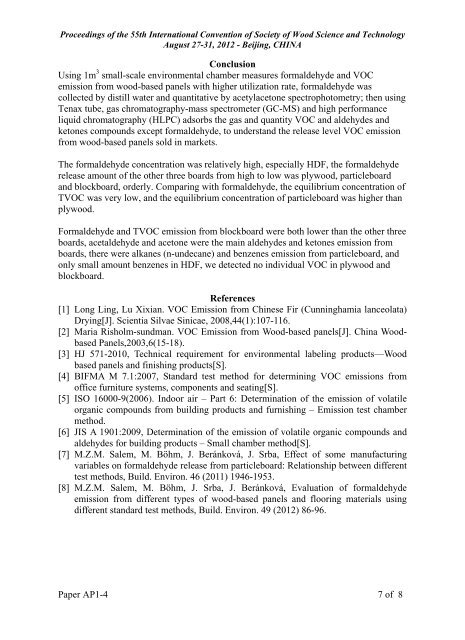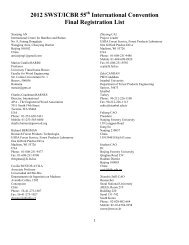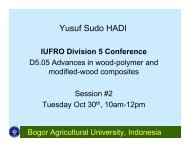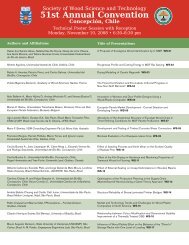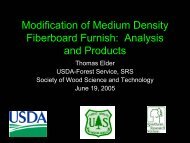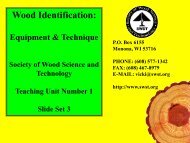AP1-4 - Society of Wood Science and Technology
AP1-4 - Society of Wood Science and Technology
AP1-4 - Society of Wood Science and Technology
Create successful ePaper yourself
Turn your PDF publications into a flip-book with our unique Google optimized e-Paper software.
Proceedings <strong>of</strong> the 55th International Convention <strong>of</strong> <strong>Society</strong> <strong>of</strong> <strong>Wood</strong> <strong>Science</strong> <strong>and</strong> <strong>Technology</strong>August 27-31, 2012 - Beijing, CHINAConclusionUsing 1m 3 small-scale environmental chamber measures formaldehyde <strong>and</strong> VOCemission from wood-based panels with higher utilization rate, formaldehyde wascollected by distill water <strong>and</strong> quantitative by acetylacetone spectrophotometry; then usingTenax tube, gas chromatography-mass spectrometer (GC-MS) <strong>and</strong> high performanceliquid chromatography (HLPC) adsorbs the gas <strong>and</strong> quantity VOC <strong>and</strong> aldehydes <strong>and</strong>ketones compounds except formaldehyde, to underst<strong>and</strong> the release level VOC emissionfrom wood-based panels sold in markets.The formaldehyde concentration was relatively high, especially HDF, the formaldehyderelease amount <strong>of</strong> the other three boards from high to low was plywood, particleboard<strong>and</strong> blockboard, orderly. Comparing with formaldehyde, the equilibrium concentration <strong>of</strong>TVOC was very low, <strong>and</strong> the equilibrium concentration <strong>of</strong> particleboard was higher thanplywood.Formaldehyde <strong>and</strong> TVOC emission from blockboard were both lower than the other threeboards, acetaldehyde <strong>and</strong> acetone were the main aldehydes <strong>and</strong> ketones emission fromboards, there were alkanes (n-undecane) <strong>and</strong> benzenes emission from particleboard, <strong>and</strong>only small amount benzenes in HDF, we detected no individual VOC in plywood <strong>and</strong>blockboard.References[1] Long Ling, Lu Xixian. VOC Emission from Chinese Fir (Cunninghamia lanceolata)Drying[J]. Scientia Silvae Sinicae, 2008,44(1):107-116.[2] Maria Risholm-sundman. VOC Emission from <strong>Wood</strong>-based panels[J]. China <strong>Wood</strong>basedPanels,2003,6(15-18).[3] HJ 571-2010, Technical requirement for environmental labeling products—<strong>Wood</strong>based panels <strong>and</strong> finishing products[S].[4] BIFMA M 7.1:2007, St<strong>and</strong>ard test method for determining VOC emissions from<strong>of</strong>fice furniture systems, components <strong>and</strong> seating[S].[5] ISO 16000-9(2006). Indoor air – Part 6: Determination <strong>of</strong> the emission <strong>of</strong> volatileorganic compounds from building products <strong>and</strong> furnishing – Emission test chambermethod.[6] JIS A 1901:2009, Determination <strong>of</strong> the emission <strong>of</strong> volatile organic compounds <strong>and</strong>aldehydes for building products – Small chamber method[S].[7] M.Z.M. Salem, M. Böhm, J. Beránková, J. Srba, Effect <strong>of</strong> some manufacturingvariables on formaldehyde release from particleboard: Relationship between differenttest methods, Build. Environ. 46 (2011) 1946-1953.[8] M.Z.M. Salem, M. Böhm, J. Srba, J. Beránková, Evaluation <strong>of</strong> formaldehydeemission from different types <strong>of</strong> wood-based panels <strong>and</strong> flooring materials usingdifferent st<strong>and</strong>ard test methods, Build. Environ. 49 (2012) 86-96.Paper <strong>AP1</strong>-4 7 <strong>of</strong> 8


